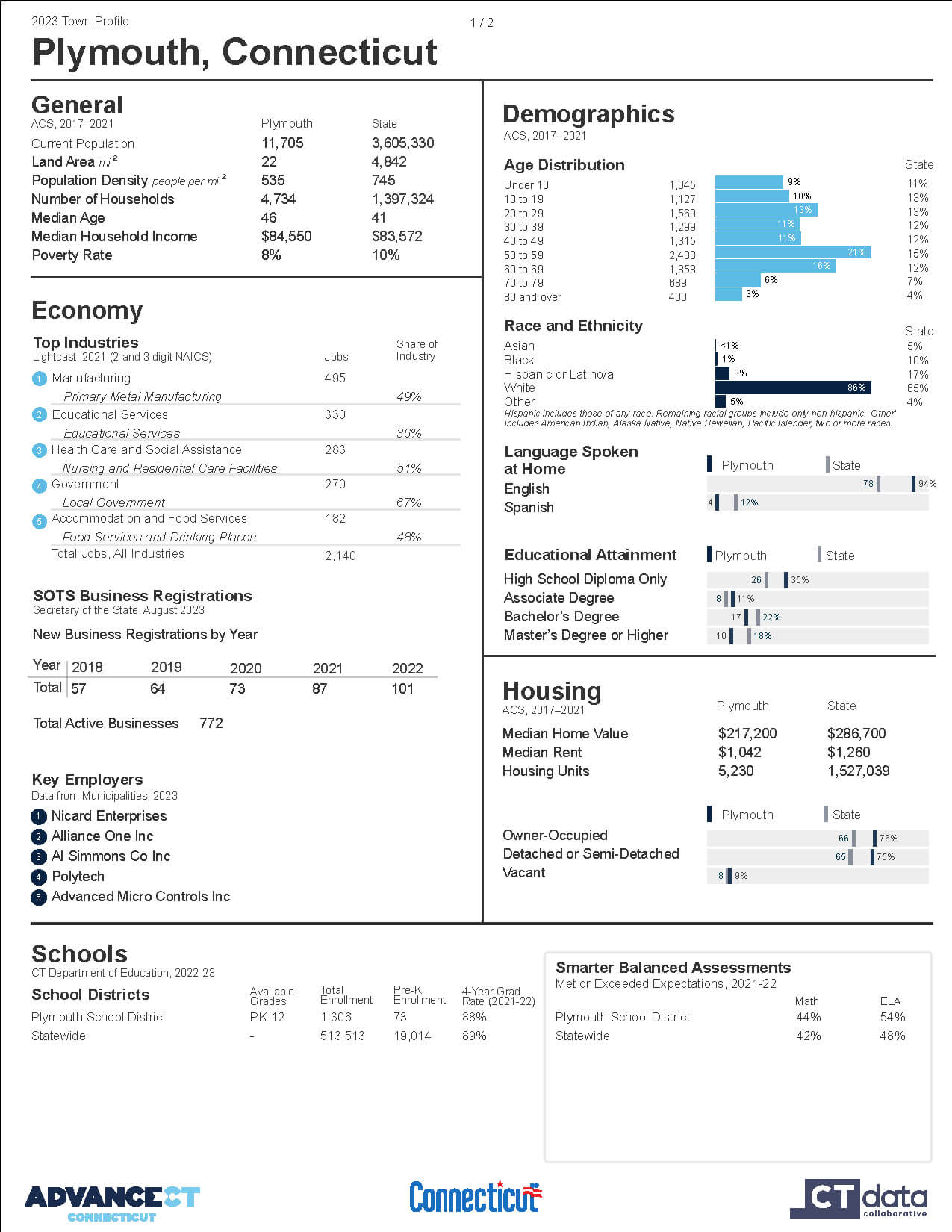Town of
Plymouth

About Plymouth
Plymouth is comprised of three sections: Plymouth Center, Pequabuck, and Terryville. It is a community of 12,000 with a land area of 22 square miles in the southeast corner of Litchfield County.
There are 5,200 housing units in town and a median sales price of $217,000. The median household income is $84,550. Plymouth has a mayor/town council form of government.
HISTORY
The town of Plymouth was incorporated in 1795 from the society of Northbury. Manufacturing was an important element of the Plymouth economy, from Eli Terry’s world famous clocks in the 1790s to the manufacture of locks beginning in the 1830s.
The Plymouth Center Historic District contains126 historic assets such as buildings, sites and objects. The focal point of the 136acre site is Plymouth Center Village where Union troops reportedly drilled during the Civil War. It is now home to the Plymouth Congregational Church, which contains the only Eli Terry wooden works tower clock in existence. The District was accepted into the National Register of Historic Places in 1999.
Another, smaller district, known as East Plymouth, was accepted in 1984. It lies north of Terryville against the Bristol line. Lastly, the Terryville Water Wheel was placed on the National Register in 2002. Dating back to 1851,it powered the Lewis Lock Company, which, in 1854,merged with James Terry & Company (Eli’s grandson) to become the Eagle Lock Company.
BUSINESS CLIMATE
Plymouth’s business heritage is being perpetuated through the expansion of the Plymouth Business Park. Begun in the early 1970s, the Park contains 25 companies totaling over 425,000 square feet of floor space. Expansions, either under construction or in the design/permit stage, will add another 50,000 square feet. The town’s Economic Development Commission is marketing the remaining parcels. The Plymouth Business Park is well suited either for companies having synergistic relationships with other area businesses or for those wishing to relocate to a suburban setting.
TOWN SERVICES
Evergreen is Plymouth’s first active adult retirement condominium community, with 130 units on 62 acres located on South Street. Residents have access to a library, dining area, woodworking shop, computer room with internet access, and a swimming pool with fitness center and whirlpool spa.
Plymouth supports two public libraries, one in Terryville and one in Plymouth Center. The town is served by a full-time police department, a volunteer fire department and a volunteer ambulance corps.
EDUCATION
Plymouth is served by four public schools. Eli Terry Jr. Middle School was moved to the town’s old high school building after renovations in 2008 and Terryville High School moved to its brand new location. Harry S. Fisher Elementary and Plymouth Center School serve as the town’s two elementary schools, grades K-5.
RECREATION
The 27-acre, town-owned Lake Winfield Park features walking trail, tennis courts, and a playscape. Both Little League and the Terryville Youth Soccer Club provide organized youth sports activities.
The Hancock Dam Flood Control Area, approximately700 acres of federal flood control area including a 40-acre lake, is adjacent to the650-acre Mattatuck State Forest and a 500-acrereservation maintained by the Boy Scouts of America. Two segments of the Blue Trail System, the Mattatuck Trail and the Tunxis Trail, pass through the area. The Town Forest, a tract of approximately46 acres, features a hiking trail with interpretive nature stations.
The Terryville Country Fair is held annually in the fall and is sponsored by the Terryville Lions Club, which maintains the fairgrounds. The town is home to the Lock Museum of America, founded in 1971 with locks from the Eagle Lock Company collection. It now holds the largest collection of early American locks in the country. The total collection, including locks from around the world, exceeds 20,000pieces.
In early 2005, the town adopted its new Plan of Conservation and development. Subtitled ”Connecting to the Future,” the plan utilizes the town’s natural resources in guiding development, maintaining open space and creating pedestrian linkages while protecting its rural heritage. The town has created a Village District from Benedict Street to Allen Street and has established streetscape design through various grants which will connect our rural heritage to our future legacies.

